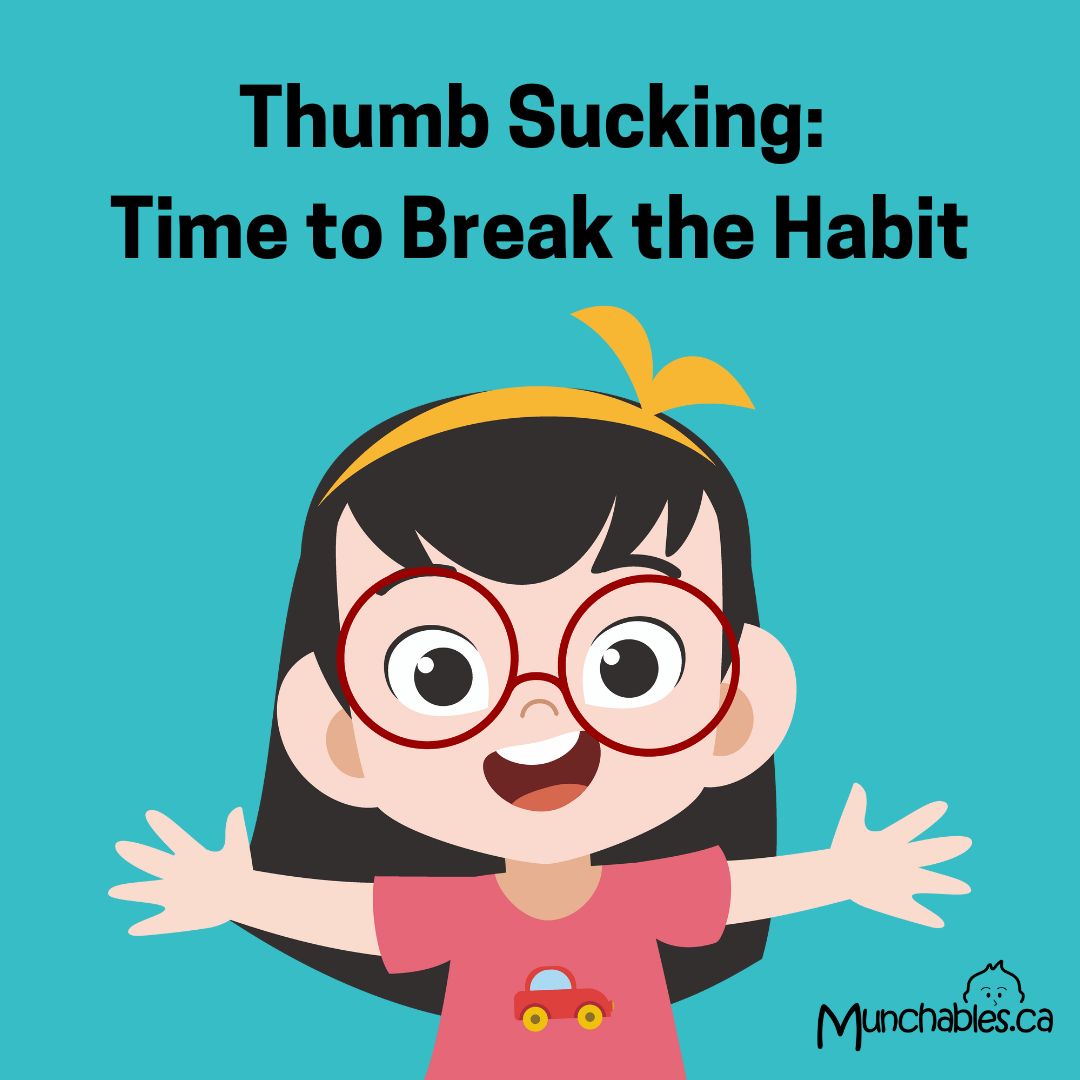
Thumb Sucking: Time to Break the Habit
After a child reaches about three years old, many caregivers are ready for thumb and finger sucking to be left behind in toddlerhood.

The most critical impact of continued thumb-sucking is irreparable skeletal changes to the jaw and teeth. The continued outward pressure of a thumb/finger on the front teeth can cause many children, by the age of 3-4, to have gaps between their upper and lower teeth. This can cause these kids to struggle with speech - in particular, the sounds "s" and "th". As permanent teeth begin to emerge, continued thumb sucking can cause "buck teeth". Please consult your pediatric dentist if you are concerned.
5 Tips to Stop Thumb & Finger Sucking:
1. TALK
Start a calm conversation with your child to explain your specific concerns over their behaviour. As we parents know, an internally motivated child is much more likely to experience success. I encourage you to keep the conversation positive and not shame your child into stopping their behaviour. Remember that thumb sucking is a self-soothing habit that your child has been doing for years. It isn't going to stop overnight - or even after only a few weeks.
Talking Points to Consider
-
Germs — Many of us have had conversations with our children about Covid, common colds and the flu. Emphasize to your children that every time they put their hands in their mouths, they are licking up germs. I found this moldy bread experiment to be very helpful for my two children to understand just how dirty their hands are.
- Speech — If your child struggles to make themselves understood, this may be a positive motivator. Explain to your child that their "S", "D", "T" and "TH" sounds will be much clearer if they stop sucking. (Due to the detrimental development of the teeth, jaw and palate.)
- Appearance — I recommend trying this approach last. You could tell your child that their persistent thumb-sucking can result in buck-teeth. If appropriate, you can share an image to emphasize your concern. If applicable, you can also describe your experience with braces to fix your own teeth.
2. CHEWELRY

Chewable jewelry can be an ideal substitute for a thumb or finger. Chewable jewelry is a safe, non-toxic, inexpensive way to divert sucking/chewing from fingers or nails. Chewelry can come in the form of necklaces, bracelets, pencil toppers, zipper pulls and more. I’ve had feedback from many parents over the years that our chews have stopped sucking in its tracks. Children transition to the chewy and then phase it out completely. I recommend letting your child choose the chewelry they want to wear. Curl up with your child and explore together the options on the Munchables website. Munchables chewelry ranges from $7-20.
3. “ICKY" NAIL POLISH

Foul tasting nail polish can work wonders for some children. Be aware that many children quickly grow accustomed to the taste of these polishes and many different flavors may need to be purchased. Also, for children with heightened sensitivities, the “icky” taste will linger in the mouth for a long time causing some children much distress. One of the potential downsides of nail polish is that many children thumb/finger suck while sleeping when their taste buds are “turned off”. If your child is a nocturnal sucker, a physical guard may be the best option.
It is hard to argue with the inconspicuous nature of this technique! It sells for $8-12 on Amazon or at major pharmacies. Unlike chewelry, foul-tasting nail polish does introduce potentially toxic chemicals into a child’s mouth. Please stick to reputable brands such as “Onyx Professional "Stop The Bite" Nail Biting & Thumb Sucking Deterrent” or “Mavala Stop Deterrent Nail Polish Treatment”.
4. PHYSICAL THUMB OR FINGER COVER

A physical barrier is another option to consider; however, I don’t love this one due to its price point and design. Physical guards significantly inhibit hand use. Developing fine motor skills will be next to impossible if a child frequently wears one of these. If this is something you’d like to try, check out TGuard (pictured) (~$60), or Dr. Thumb (~$40).
5. PHYSICAL RESTRAINT OF ELBOW

The colourful NIPIT can be used to severely impair elbow movement. Using an arm brace will prevent children from getting their hands to their mouths.The NIPIT is hard to remove as it features strong Velcro and many parents have found sucess with this brace. Reviews on Amazon indicate that the strong velcro is no obstacle for a very determined child pushing the restraint up or down the arm. Please note that this is not a good option for many sensory sensitive children. If interested in this option, I recommend first trying out standard 3” bandage wraps to see how your child reacts to being restrained. The NIPIT retails for $45 on Amazon.
⚠ WARNING — DO NOT USE HOT SAUCE

Many parents have regretted putting hot sauce on their child's nails to stop sucking/biting. Unfortunately, the hot sauce inevitably gets in the child's eyes causing excruciating pain. Please don't try this method.
If you see success…
Praise, praise and more praise! Positive reinforcement will build up your child’s inner willpower!
If you don’t see success…
Breathe. Stay calm. An agitated child will likely increase thumb/finger sucking and may start biting their fingers to self-soothe. (Read here for more information on chewing.)
Distract! Stop sucking by giving a child a fidget toy to occupy their hands. Fingers can’t be both in the mouth and manipulating a fun stim toy.
Finally, remember, this is a habit well ingrained in your child’s psyche. Your child first started to thumb suck as a way to self soothe. They’ve been doing it a long time! Think of other hard to break habits – nose-picking, nail biting and my arch nemesis – chewing with an open mouth.
Be patient and encouraged by gradual change.
Best of luck!
Laura May, Owner
Munchables Sensory Solutions Ltd.
